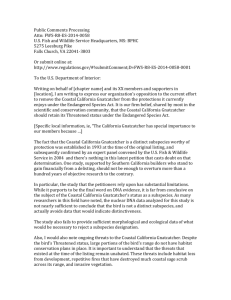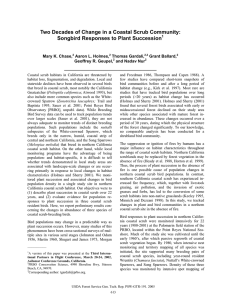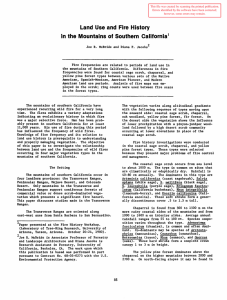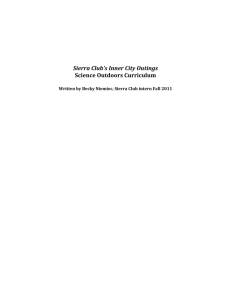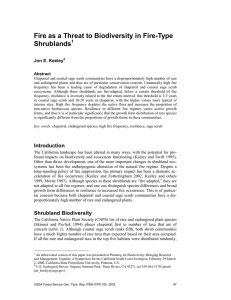Introduction
advertisement
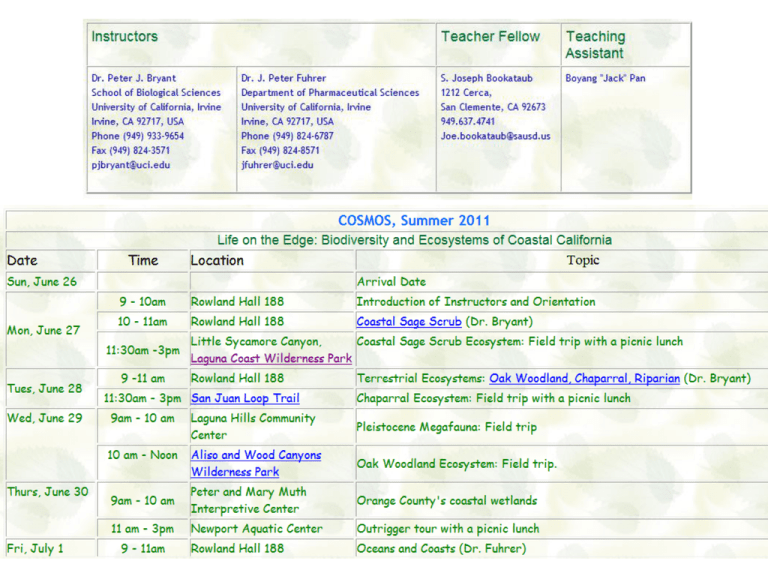
Number of Species on Earth 1,400,000 animal sp. 320,000 plant sp. Estimated # of tropical species (based on birds) = 2-3 x temperate = 2.8-4.2 million So total = 4.2-5.6 million The Creator, if He exists, has "an inordinate fondness for beetles". – J.B.S. Haldane Number of species in different animal groups 3/4 of all animals (>1 million species) are insects! GEOGRAPHICAL DISTRIBUTION OF SPECIES: Terrestrial ecoregions Olson, D. M., et al (2001). Terrestrial ecoregions of the world: A new map of life on Earth.BioScience 51(11): 933-938. Ecoregion: a large area of land or water that contains a geographically distinct assemblage of natural communities that (a) share a large majority of their species and ecological dynamics; (b) share similar environmental conditions, and; (c) interact ecologically in ways that are critical for their long-term persistence. 52 Ecoregions in U.S. 261: California Coastal Chaparral Forest Shrub Province. 261: California Coastal Chaparral / Forest Shrub Province. • Climate. -- Hot, dry summers; rainy, mild winters. – – – – Annual temperatures average 50º to 65 º F (10 º to 18 º C). Annual precipitation 10-50 in. with a pronounced summer drought. Some moisture from fog in summer. Fire is common, usually set by lightning during the summer dry season. • Vegetation. – Riparian forest with many broadleaf species grows along streams. Willow, Mulefat – Sclerophyll forest on the hills and lower mountains. Live oak, white oak – Chaparral on steep hill and mountain slopes too dry to support oak woodland or oak forest. Chamise and various manzanitas. – Coastal Sage Scrub on exposed coastal areas. Buckwheat, Deerweed, Coyote bush, Black Sage, White Sage, California sagebrush, and bush lupine. 25 Biodiversity Hotspots 1.44% of the Earth's land surface, supporting ~70% of all plant species. Account for 44% of all plant diversity, 35% of all terrestrial vertebrate species, and 75% of all terrestrial animal species listed as threatened by the IUCNWorld Conservation Union. California Floristic Province CALIFORNIA • Biologically, most diverse state in the Union • 40,000 species • More federally listed (i.e. Endangered and Threatened) species than any other mainland state • Human population expected to grow from 32 million to 49 million by 2025 Species Diversity by State Endemic Species by State Species Extinction by State Listed Species by State Endangered Species in the U.S. Southern California: a "hot spot" of threatened biodiversity Plants Fish Birds Molluscs (Dobson et al., Science 275, 550 (1997) Threatened, Endangered and Candidate Species in California (terrestrial vertebrates) California's native Native ecosystems (a selection) California’s Ecosystems selection) Pe(arce nt lost Native grassland Needlegrass steppe San Diego County coastal strand Southern San Joaquin Valley alkali sink scrub San Diego County maritime sage scrub Coastal redwood forest Riparian woodland Wetlands Central Valley wetlands Central Valley vernal pools San Diego County vernal pools San Diego County freshwater marsh San Diego County coastal salt marsh San Francisco Bay seasonal wetlands Coastal sage scrub % lost 99 99.9 100 99 92 85 89 91 95 66-88 97 90 88 90 70-90 Noss, R.F. (1994) Calif ornia's ecosy stem decline. Def enders 69 (4) 34-35 California's natural communities Where have they gone? Forests - logged Native grasslands - converted to agriculture, overgrazed, invaded by exotics Wetlands - drained Streams - channelized and dammed Coastal sage scrub - converted to subdivisions, shopping malls, highways Sclerophylls: leaves are small , hard, stiff, waxy, evergreen Mediterranean ecosystems http://conserveonline.org/workspaces/global.med.assessment CA • Five distinct regions • Hot, dry summers and cool, wet winters. • 2.2% of the Earth's surface, but support 20% of the world's plant species. • >50% of the plant species are endemic: found nowhere else • All threatened by urbanization, land conversion, invasive species, altered fire regimes, excess grazing, tourism and climate change. California Ecosystems Coastal Sage Scrub • 0-1500 feet elevation • California sagebrush (Artemesia californica), black sage, white sage, buckwheat and other drought-deciduous shrubs • ~90% lost to development •California Quail, Callipepla californica Chaparral 500-4,500 feet elevation. •Evergreen dense canopy 5-15 feet high containing chamise, manzanita, ceanothus, lemonade berry, scrub oak, toyon, mountain mahogany, yucca •Leaves contain flammable resins, but the plants are fire-adapted Oak Woodland 1,500-4,500 feet elevation. •Evergreen oaks and sycamores •Poison oak, elderberry, coffeeberry, manzanita. Mixed Conifer Forest > 4,500 feet elevation. • Coulter pine, jeffrey pine, white fir, Incense cedar, black oak, canyon live oak. Also shrubs and grasses • Huge losses to timber harvesting Desert • East of the Peninsular Mountains • Low rainfall, high evaporation • Many plants are succulent: they store water in their stems and/or leaves • Creosote bush, desert willow, agave, indigo bush, chuparosa, beavertail cactus, cholla cacti, barrel cactus, smoke tree, saltbush, ocotillo, palo verde tree, desert fan palm, lupine, primrose, and verbena. Riparian • Alongside streams and lakes • Willow, sycamore, cottonwood, mule fat. • Huge losses due to channelization and damming http://www.prbo.org/calpif/plans.html Wetlands • Inundated or saturated by water at least part of the time. • Five major types: marine, estuarine, lakes (including vernal pools), rivers, and marshes, swamps and bogs. • Most lost to draining, filling, harbor development http://www.beachcalifornia.com/wetlands-california-birds-photos.html Vernal Pools • Seasonally flooded depressions on an impermeable layer • Specially adapted plants that flower in succession as the pool dries, giving concentric rings of color http://nathistoc.bio.uci.edu/



